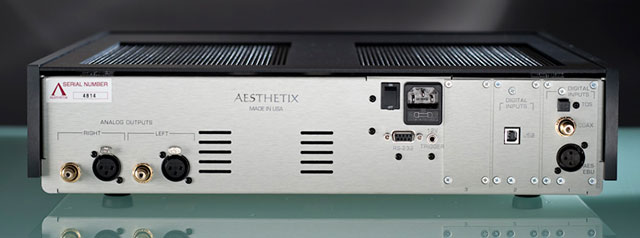Aesthetix Romulus Signature

Design and Features
 The Aesthetix Romulus is a vacuum tube-output Red Book CD player that incorporates all the features and functions of the Aesthetix Pandora DAC. Besides being a happy Aesthetix Calypso Signature owner, what attracted me to the Pandora and Romulus was versatility. The user can purchase as much or as little as they need. Need a high-quality DAC with a wide selection of inputs, you got it. Need to spin CDs, you are covered. Add volume control and you can eliminate a preamplifier if you do not have any analog sources.
The Aesthetix Romulus is a vacuum tube-output Red Book CD player that incorporates all the features and functions of the Aesthetix Pandora DAC. Besides being a happy Aesthetix Calypso Signature owner, what attracted me to the Pandora and Romulus was versatility. The user can purchase as much or as little as they need. Need a high-quality DAC with a wide selection of inputs, you got it. Need to spin CDs, you are covered. Add volume control and you can eliminate a preamplifier if you do not have any analog sources.
Another versatile feature that attracted me was the presence of both single-ended and fully-balanced inputs and outputs. I am a big fan of balanced connections and tend to avoid equipment that does not include them. Since the Romulus and Pandora are so closely related it is impossible to review one without most comments being relevant to the other. The unit reviewed is a Romulus Signature with the optional volume control.

The Signature versions include several significant upgrades over the standard versions. In the Signature versions critical coupling and output capacitors are replaced with Dynamicaps. The four standard rubber feet are replaced with Harmonic Resolutions Systems’ Nimbus Couplers specially made for Aesthetix. The Nimbus Couplers really stick equipment to my wood shelves. It takes some effort to break their grip but they never left a mark.
What some might consider the most significant addition is that the Signature versions offer true native DSD 1x and 2x functionality over USB and 1x DSD over SPDIF (AES/EBU, RCA Coax and TosLink). Some DACs convert DSD to PCM but not the Aesthetix products. No alteration of DSD data occurs. DSD data passes directly to the DAC where Vishay Z-foil audio resistors are utilized in the critical current-to-voltage conversion stage.
In addition to the flexibility of configuration and the multiple inputs it is necessary to look at the quality of construction and attention to detail in these two (actually all of) Aesthetix offerings. Both the Pandora and Romulus employ three transformers, one each for digital circuits, analog circuits, and control functions. There are also multiple stainless steel faraday cages to isolate digital, analog, and power supply sections. The DAC chip is a Burr-Brown PCM 1792A run in pure differential mode to maximize noise cancellation. Separate power supplies isolate the analog and digital circuits. The analog section utilizes two vacuum tubes (one 12AX7 and one 6DJ8/6922) per channel in differential configuration with zero feedback.
Even though the Romulus incorporates the same features and construction of the Pandora, to say a Romulus is merely a Pandora with a Red Book CD transport added would be a major understatement. It is not a simple “add-on”. As with every Aesthetix product, all aspects are thoroughly designed and tested before the product is offered for sale. To provide Red Book CD playback, a special audio-purpose Teac mechanism is isolated in its own faraday cage. Further isolation is provided by the addition of a separate power supply with two transformers and three linear regulation stages. Data is retrieved directly from the IDE bus thus enabling the DAC to provide the master clock (ultra-high quality crystal oscillator) and minimize jitter. The sum total is significantly more than just adding an optical drive.

Opening and closing of the CD drawer is dead silent except for the final lock-in-place. The drawer is programmed to close automatically to prevent accidental damage from bumping in the event the user forgets to close it. The drawer stays open for approximately 40 seconds with the last 10 seconds counted down on the display if the display is not turned off. A minor complaint I have is with the remote. Because the same remote is shared with multiple Aesthetix products it has two sets of numbered keys. One set is for the CD tracks and the other is for inputs. Numbering the inputs is redundant since the body of the remote lists them by type (e.g. USB, RCA, etc.). I frequently pressed the wrong numbered set. I am not too old of a dog to learn new tricks and would have gotten properly trained if I used the CD player more. While I used the player for this review, for everyday listening I used the DAC connected to my LauferTeknik 64-Bit Memory Player via an AES/EBU cable. I did however use the CD player to burn in the entire unit playing CDs 24/7 in repeat mode. I abused it and it never complained or faltered.
What I did use extensively was the volume control. The Pandora and Romulus volume controls operate partially in the digital domain for small 1dB steps and partially in the analog domain using relay-based switched resistors for large 6dB steps. This combination results in eighty-eight 1dB steps while avoiding the resolution that would be lost playing music at normal or low levels if volume was controlled exclusively digitally. My experience was the volume control responded at a speed that was somewhat frighteningly slow when I switched CDs and needed to cut volume quickly. However, once the volume was in the appropriate range, the fine tuning was smooth, precise and much appreciated. The remote worked extremely well in that capacity. On the unit itself, volume control is cleverly incorporated into the digital display screen. Press the left side to lower the volume and press the right side to raise the volume. On the faceplate of the Romulus, CD-player functions are provided via the signatureAesthetix “A”-shaped buttons.
Performance
 I used the Romulus Signature for months directly into my amplifiers and thoroughly enjoyed the smooth adjustment performance offered by the 1dB steps. Sonically I was surprised at how good it sounded into two radically different design amplifiers—a Sanders Sound Systems Magtech and an Audio Research Corporation Reference 75.
I used the Romulus Signature for months directly into my amplifiers and thoroughly enjoyed the smooth adjustment performance offered by the 1dB steps. Sonically I was surprised at how good it sounded into two radically different design amplifiers—a Sanders Sound Systems Magtech and an Audio Research Corporation Reference 75.
I know I am not alone in my experience and division over what sounds best—DAC with volume control directly into an amplifier or use a preamplifier in between. There is something about apparent resolution gained by direct drive versus the impact and dimensionality added by a good preamplifier. For months I enjoyed the Romulus directly into either of my two amplifiers without feeling I had given up anything. The combinations were totally enjoyable. Adding an Aesthetix Calypso Signature into the mix felt like cheating since it had NOS tubes (Telefunken and Mullard). But inquiring minds need to know.
The Calypso Signature provided a slight improvement to impact and holographic presentation. No surprise there. What did surprise me was how minimal the improvement was. I should note that the differences in performance between direct-drive and with a preamplifier were much the same quality and magnitude that I noticed between a Calypso Signature with stock tubes and NOS tubes. That points out an important difference between the Aesthetix products and solid-state offerings. With solid-state designs, what you get is what you are stuck with. Aesthetix products allow the user to fine-tune to their system and taste.
I should also note here that this review started out with a standard Romulus with volume control. I upgraded when the Signature option became available. On the standard version I did notice a more significant difference between direct-drive and using a preamplifier. I had originally wanted to do a review comparing the standard and Signature versions but the time it took to get the upgrade completed and burned in prevented a credible comparison of minor attributes. However, I am dead certain of the differences using the units directly into an amplifier versus using a preamplifier. The Signature version reduced the differences. I am confident a tube upgrade would also reduce differences.
Listen up

Beth Hart is a barometer for me. For my tastes, her voice can go from bluesy and somewhat sweet to slightly abrasive and tiresome. Sometimes that shift takes place in different parts of the same song and definitely from song to song as on her collaborative CD with Joe Bonamassa Don’t Explain [J&R Adventures PRAR931391]. The shift is subtle but I get it right away so, besides enjoying her music in general, I find some of her tracks great for testing. The Romulus Signature captured allof the nuancesin her voice without tipping it into the offensive (to me) area. I never felt like anything was taken away or smoothed over. Rather what I was enjoying felt like all the music with no digital glare or edge added.

On more robust performances I did hear a larger difference. With the Calypso Signature preamplifier connected there was more of what the tracks were designed to do, that being kick ass. On tracks like “Slow Train” from the CD An Acoustic Evening at the

Vienna Opera House [J&R Adventures PRAR 944445] from Joe Bonamassa and the totally slammin’ “Tamacun” from rodrigo y gabriela’s CD Live in Japan [ATO Records ATO0062 88088-21638-2] a preamplifier proved to be an asset. But the difference was most noted going backward. In other words once I got used to hearing the extra drive and solidity of the Calypso Signature I could more readily tell the Romulus Signature alone was slightly lighter.
In fairness I should mention that Quads are not the best speakers for that type of material and it takes a lot to motivate them. Consider the benefitof a preamplifier based upon your musical tastes, speakers, and budget. It is not a surprise that adding a preamplifier that comes close to the cost of the Romulus makes a difference. There is always more to be had if you want to pay for it.
To describe the performance in broad terms I would say the Aesthetix units incorporate the sonic benefits of vacuum tubes without getting too dense or overly romantic while maintaining the solid-state attributes of detail and impact. There is none of the “typical” digital harshness or dryness of much of the all-solid-state equipment. But do not interpret this as a panacea for poorly recorded or noisy CDs. The Romulus and Pandora will reveal flaws as well as virtues.
Conclusion
The Aesthetix Romulus and Pandora standard and Signature versions are real winners for both performance and value. I judge value by multiple parameters and the Pandora and Romulus meet all of those criteria.
The versatility of configuration as a DAC, CD player with DAC inputs, or a preamplifier for an all-digital system makes it a rare if not unique audio component. Certainly the vacuum tube analog stage adds to that uniqueness. Audio performance and build quality are outstanding. Although the units are not inexpensive in absolute terms, one must consider the number of components and expensive cabling they replace if the user chooses to forgo a separate preamplifier or transport plus DAC (in the case of the Romulus).
A major component of value that is often ignored is brand reputation and history. To me that means how well a particular product will stand the test of time with respect to service and upgrades and, ultimately, resale value. I have personally had many products “orphaned” either by the company going out of business or succumbing to the compulsion to constantly design new products while abandoning support for previous designs. Aesthetix is a company that gives me a feeling of security. Jim White, President and Chief Designer of Aesthetix, does not feel the need to constantly obsolete products to generate new sales.Product changes at Aesthetix are slow to evolve because they will be done correctly and will stand the test of time. In my book that is real value.


Specifications
The Romulus includes the same features and construction as Pandora, but adds a CD transport mechanism:
Price: Pandora $6,000, Romulus $7,000; Signature Versions add $3,000, optional volume control add $1,000
Dimensions: 18″ width x 4 3/8″ height x 18″ depth
Weight: Pandora 35 lbs (Romulus 40 lbs)
Inputs: One each: S/PDIF (RCA Coax 24/192), AES/EBU (24/192), Toslink, asynchronous USB switch selectable Class1 (24/96)/Class 2 (24/192), USBsecond input is optional
Outputs: One pair each Single-Ended (RCA) and balanced (XLR)
Digital Section: 32KHz, 44.1KHz, 48KHz, 88.2KHz, 96KHz, 176.4KHz, 192KHz, all with 24 bit resolution
Features: RS232 control, 12 volt trigger, remote control
Address:
Aesthetix
5220 Gabbert Road Suite A
Moorpark, CA 93021
Telephone: 805-529-9901
Email: info@aesthetix.net
Website: http://www.aesthetix.net
Stereo Times Masthead
Publisher/Founder
Clement Perry
Editor
Dave Thomas
Senior Editors
Frank Alles, Mike Girardi, Key Kim, Russell Lichter, Terry London, Moreno Mitchell, Paul Szabady, Bill Wells, Mike Wright, Stephen Yan, and Rob Dockery
Current Contributors
David Abramson, Tim Barrall, Dave Allison, Ron Cook, Lewis Dardick, Dan Secula, Don Shaulis, Greg Simmons, Eric Teh, Greg Voth, Richard Willie, Ed Van Winkle, and Rob Dockery
Music Reviewers:
Carlos Sanchez, John Jonczyk, John Sprung and Russell Lichter
Site Management Clement Perry
Ad Designer: Martin Perry





Be the first to comment on: Aesthetix Romulus Signature